Oludeniz History Facts and Timeline
(Oludeniz, Mugla Province, Turkey)
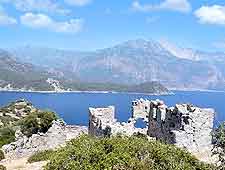
One of the world's most gorgeous beaches can be found at Oludeniz, a very popular resort town on Turkey's south-western Aegean coast. Just 12 km / 7 miles south of Fethiye, one of the main tourist towns in this region, Oludeniz has a history anchored almost entirely in the modern tourism trade.
With the steep Babadag Mountain rising sharply behind the beach, Oludeniz is both incredibly scenic and an ideal spot for sports such as paragliding. Its name means 'Dead Sea' or 'Blue Lagoon', which relates to the rich spectrum of blues and greens of the sea in its sheltered inlet.
Belcegiz
Since the entrance to the protected harbour at Oludeniz is so narrow, it was never really favoured in ancient times as a port settlement. The town began its life as a small village called Belcegiz, although this remained little more than a quiet fishing hamlet.
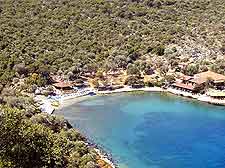
The area surrounding Oludeniz, however, has a history as rich and exciting as anything in Turkey. This corner of south-western Turkey was known as Lycia in ancient times, boasting a heritage that stretches back over 3,000 years.
Lycia History
The progressive Lycian civilisation was a collective of cities that formed a federation based on common democratic ideals. While nothing from this era remains in Oludeniz itself, just minutes away are some truly outstanding ancient towns dating from the Lycian period.
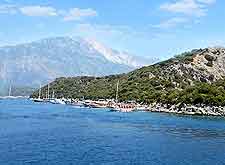
Among the closest ruins are those at Dalyan, a marvellous place of Lycian tombs, columns and pillars carved into the steep hillside above Oludeniz. Tlos is another important city of that era some 32 km / 20 miles to the east. It is one of the oldest from the Lycian federation and famous for being the home of Pegasus, the winged horse of Greek mythology.
Turkish and Greek Rivals
In modern times, Oludeniz has been near key flashpoints in the long-standing territorial rivalry between Turkey and
Greece. Some 6 km / 4 miles to the west, Kayakoy is a ghost town that was emptied out in 1923 following the Greco-Turkish War (1919 to 1922). The mainly Greek population of this town was forcibly relocated to Greece and the town has been empty ever since. Before the war, Kayakoy was a bustling place of some 2,000 people. Now all that remains are crumbling Greek Orthodox churches and houses.
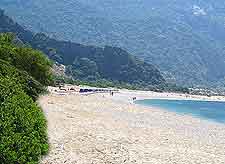
A Resort Town is Born
When the Turquoise Coast, as this section of Turkey's Aegean Sea is called, was first developed in the 1960s, Oludeniz quickly emerged as a popular destination. With Fethiye just a few minutes down the road, visitors soon began flocking to the superb beach and its blue waters. Thankfully, the Turkish government realised the value of Belcekiz Cove (the Blue Lagoon) and declared the area surrounding it a national park.
This move kept development away from the actual lagoon and helped to ensure that the modern history of Oludeniz had a positive ending.
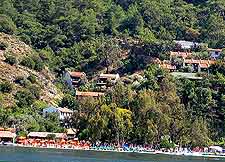
The resort town amenities are nicely separated along the main beach, while Belcekiz Cove remains absolutely pristine. For obvious reasons, the main leisure activity here is sailing.
The unique steepness of Babadag Mountain directly behind Oludeniz has also turned this resort into one of the world's top destinations for paragliding. Even land-lovers have the amazing option of hiking a section of the Lycian Way, a 500-km / 310-mile trail that runs all the way to Olympus and is considered one of the world's top ten epic walks.
 One of the world's most gorgeous beaches can be found at Oludeniz, a very popular resort town on Turkey's south-western Aegean coast. Just 12 km / 7 miles south of Fethiye, one of the main tourist towns in this region, Oludeniz has a history anchored almost entirely in the modern tourism trade.
One of the world's most gorgeous beaches can be found at Oludeniz, a very popular resort town on Turkey's south-western Aegean coast. Just 12 km / 7 miles south of Fethiye, one of the main tourist towns in this region, Oludeniz has a history anchored almost entirely in the modern tourism trade. The area surrounding Oludeniz, however, has a history as rich and exciting as anything in Turkey. This corner of south-western Turkey was known as Lycia in ancient times, boasting a heritage that stretches back over 3,000 years.
The area surrounding Oludeniz, however, has a history as rich and exciting as anything in Turkey. This corner of south-western Turkey was known as Lycia in ancient times, boasting a heritage that stretches back over 3,000 years. Among the closest ruins are those at Dalyan, a marvellous place of Lycian tombs, columns and pillars carved into the steep hillside above Oludeniz. Tlos is another important city of that era some 32 km / 20 miles to the east. It is one of the oldest from the Lycian federation and famous for being the home of Pegasus, the winged horse of Greek mythology.
Among the closest ruins are those at Dalyan, a marvellous place of Lycian tombs, columns and pillars carved into the steep hillside above Oludeniz. Tlos is another important city of that era some 32 km / 20 miles to the east. It is one of the oldest from the Lycian federation and famous for being the home of Pegasus, the winged horse of Greek mythology.
 The resort town amenities are nicely separated along the main beach, while Belcekiz Cove remains absolutely pristine. For obvious reasons, the main leisure activity here is sailing.
The resort town amenities are nicely separated along the main beach, while Belcekiz Cove remains absolutely pristine. For obvious reasons, the main leisure activity here is sailing.